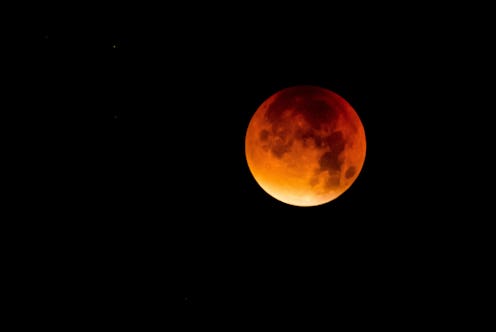Between the annular solar eclipse coming up on Sept. 1 and the penumbral lunar eclipse arriving just a few weeks later on Sept. 16, now seems like a good time to explore the difference between a solar eclipse and a lunar eclipse. I mean, we hear a lot about them on the news, especially when the weather is good and viewing conditions are expected to be nice in our areas; furthermore, even if you aren't a huge astronomy buff, you're likely to enjoy spending some time in nature watching beauty up in the sky — which naturally gives rise to some important questions. So if you've ever wondered exactly what makes a lunar eclipse different from a solar one and vice versa, let's take a deep dive and find out.
As I learned over at the NASA website, it turns out that the two astronomical events actually couldn't be more different. The only thing they really have in common is that they both involve the position of the sun, moon, and Earth, and both are typically visible from Earth. It's easy to get them confused, I think, because we call them both by the same general name — "eclipse" — even though the key word for each event is really the "solar" or "lunar" part.
Let's take a closer look at each:
What Is A Solar Eclipse?
As explained on the NASA website, a solar eclipse occurs when the moon passes in front of the sun, obscuring the sun from view. Generally, we then see the moon as a dark silhouette with a circle of light (from the sun) around it. But during a solar eclipse, because moon is blocking the sun's rays, it typically casts a shadow across the Earth beneath it.
You can actually catch sight of a solar eclipse twice a year, though they're rare to see in their full form. This only happens if you're literally in the right place at the right time, because it hinges on the moon and sun aligning just right, according to where you are seeing them from the Earth. The annular lunar eclipse that's happening on Sept. 1, for example, is only visible from Madagascar and parts of central Africa.
So What's A Lunar Eclipse, And How Is It Different?
While a solar eclipse happens when the moon comes between the sun and the Earth, a lunar eclipse happens when the Earth comes between the sun and the moon. When a lunar eclipse occurs, the Earth stops the sun's rays from reaching the moon, leaving the moon in the Earth's shadow. In general, lunar eclipses also last longer than solar ones for this reason: During one, the Earth's shadow basically engulfs the moon. This shadow is visible from basically anywhere that is experiencing night at the time (provided you have good viewing conditions, of course).
Typically, you can witness a lunar eclipse in stages. Generally, the moon is still visible during a lunar eclipse and actually appears orange or red, which is where the nickname "blood moon" comes from. Similarly to solar eclipses, there are usually at least two lunar eclipses in a calendar year. The penumbral lunar eclipse happening on Sept. 16 will be the second lunar eclipse of the year and the final eclipse for 2016.
So, there you have it! Happy stargazing, everybody!
Images: Giphy (2)
